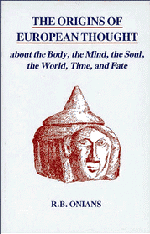Book contents
- Frontmatter
- Contents
- Preface to the first edition
- Preface to the second edition
- Introduction: The Earliest Greeks
- PART I THE MIND AND THE BODY
- PART II THE IMMORTAL SOUL AND THE BODY
- Chapter I The ψυχή
- Chapter II The Genius, Numen, etc.
- Chapter III Anima and Animus
- Chapter IV The Knees
- Chapter V The Strength
- Chapter VI The Stuff of Life
- Chapter VII River-Worship and some Forms of the Life-substance
- Chapter VIII The World: Beginnings of Greek ‘Philosophy’
- Chapter IX Death and Cremation
- Chapter X The Offerings to the Dead and to the Gods
- Chapter XI Nectar and Ambrosia
- PART III FATE AND TIME
- ADDENDA
- Indexes
Chapter X - The Offerings to the Dead and to the Gods
Published online by Cambridge University Press: 06 August 2010
- Frontmatter
- Contents
- Preface to the first edition
- Preface to the second edition
- Introduction: The Earliest Greeks
- PART I THE MIND AND THE BODY
- PART II THE IMMORTAL SOUL AND THE BODY
- Chapter I The ψυχή
- Chapter II The Genius, Numen, etc.
- Chapter III Anima and Animus
- Chapter IV The Knees
- Chapter V The Strength
- Chapter VI The Stuff of Life
- Chapter VII River-Worship and some Forms of the Life-substance
- Chapter VIII The World: Beginnings of Greek ‘Philosophy’
- Chapter IX Death and Cremation
- Chapter X The Offerings to the Dead and to the Gods
- Chapter XI Nectar and Ambrosia
- PART III FATE AND TIME
- ADDENDA
- Indexes
Summary
What of the bones from which the life-liquid and the vaporous life-soul have been liberated? The drying process of age and death has been helped to completion by the fire. The sap appears in the dry plant and it lives again. The bones have been dried even as seeds must be dry before they can spurt into new life. The dry seed needs moisture anew if it is to begin life anew. So the dry bones, it might be hoped, receiving life-liquid, might live. Those of which we have fullest account in Homer, the bones of Patroklos and Achilles, are treated in a way for which no satisfactory reason has hitherto been forthcoming. They are not preserved in a dry vessel, as we might expect, but in the Iliad those of Patroklos are taken from the ashes after quenching with wine, and are laid in ‘twofold fat (δίπλακι δημῷ)’, and in the second Nekuia in the Odyssey those of Achilles are ‘gathered in unmixed wine and grease (ἀλείϕατι, “unguent”)’. But we have seen that fat or grease (including marrow, and the vegetable equivalent, oil) was particularly identified with the liquid and liquefiable element of life, i.e. with αἰών. In the treaty curse the Homeric heroes represented the fluid of the brain (which could not be stored as fat was) by wine. The dead were above all the ‘dry ones’.
- Type
- Chapter
- Information
- The Origins of European ThoughtAbout the Body, the Mind, the Soul, the World, Time and Fate, pp. 271 - 291Publisher: Cambridge University PressPrint publication year: 1988



